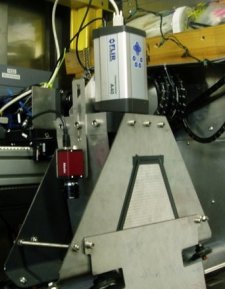Thermal Imaging for Hydrate Detection
Thermal imaging using infrared cameras is accepted by the scientific community as the most pragmatic way to determine the overall hydrate distribution in a sediment core. Dissociation/melting of gas hydrate is a strongly endothermic process which not only provides a self-preserving effect on the hydrate itself, but also cools the surrounding sediment and core liner material. Cool spots created by the unstable gas hydrate can therefore be detected on a thermal image of a fresh core that has been recovered quickly from beneath the seafloor.
Infrared Imaging Track
 The Geotek infrared imaging system consists of a computer-controlled infrared camera mounted on a skate that moves incrementally along the core, rapidly capturing thermal images. The skate maintains accurate positioning of the camera relative to the core as well as providing the necessary shielding for the core from extraneous thermal artefacts. These include sunlight and other heat sources, especially thermal reflections from people. Depth-registered thermal images of complete cores are obtained within minutes of the core being recovered. Concatenated images appended with an electronic ruler are displayed in real time on monitors distributed along the length of the track.
The Geotek infrared imaging system consists of a computer-controlled infrared camera mounted on a skate that moves incrementally along the core, rapidly capturing thermal images. The skate maintains accurate positioning of the camera relative to the core as well as providing the necessary shielding for the core from extraneous thermal artefacts. These include sunlight and other heat sources, especially thermal reflections from people. Depth-registered thermal images of complete cores are obtained within minutes of the core being recovered. Concatenated images appended with an electronic ruler are displayed in real time on monitors distributed along the length of the track.